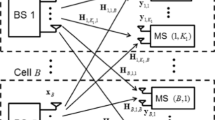Abstract
In this work, it is proposed a unified framework to design and analyze uplink distributed power control schemes over flat-fading channels from a control theory perspective. The effects of linear detectors and round trip delays are explicitly characterized in this study. First, the optimal solution to the power minimization problem under signal to interference-noise ratio (SINR) restrictions is reviewed, where sufficient conditions for its existence are presented that depends on the detection strategy. Four different linear detection schemes are studied in this work: Matched Filter, Decorrelator, MMSE and Projector. Specifically, two special cases are analyzed with respect to the spreading codes properties: uniform cross-correlation and orthogonal codes, and under both conditions an explicit expression for the central solution is obtained. Nevertheless, one drawback of the central solution is its lack of robustness against channel estimation errors, transport delays and noise. Hence, it is proposed closed-loop control laws with linear power assignment which are capable of provide robustness to these channel effects. It is then presented that under certain conditions, stable feedback loops can be obtained considering SINR quantification, transmission and processing delays, and the resulting closed-loop power solutions tend to the central ones. Finally, it is illustrated that the selection of the linear detectors does not affect the resulting closed-loop dynamics, but the uplink transmission power in steady-state. An exhaustive simulation evaluation is included to validate the mathematical analysis presented for open and closed-loop solutions.









Similar content being viewed by others
References
Gunnarsson, F. & Gustafsson, F. (2003). Control theory aspects of control in UMTS. Control Engineering Practice, 11, 1113–1125.
Baeir, P. W., Jung, P., Steil, A. (1993). Advantages of CDMA and spread spectrum techniques over FDMA and TDMA in cellular mobile radio applications. IEEE Transaction Vehicular Technology, 42, 357–364.
Schilling, D. L., Pickholtz, R. L., Milstein, L. B. (1982). Theory of spread spectrum communications-a tutorial. IEEE Transactions on Communications, 30, 855–884.
Song, W. J. (2002). Evolutionary computation and power control for radio resource management in CDMA cellular radio networks. Proceedings of the 13th IEEE International Symposium, Personal, Indoor and Mobile Radio Communications, Lisbon, Portugal, pp. 1417–1421.
Osery, A. E. (2000) Distributed power control in CDMA cellular systems. IEEE Antennas and Propagation Magazine , 42(4), 152–158.
Shakkottai, S., Rappaport, T. S., Karlsson, P. C. (2003). Cross-layer design for wireless networks. IEEE Communications Magazine, 74–80.
Srivastava, V., Motani, M. (2005). Cross-layer design: A survey and the road ahead. IEEE Communications Magazine, 112–1190.
Koskie, S., & Gajic, Z. (2006). Signal-to-interference-based power control for wireless networks: A survey, 1992–2005. Dynamics of Continuous, Discrete and Impulsive Systems B: Applications and Algorithms, 13(2), 187–220
Yates, R. D. (1995). A framework for uplink power control in cellular radio systems. IEEE Journal of Selected Areas in Communications, 13(7), 1341–1347.
Schwartz, S. C., Meshkati, F., Vincent Poor, H., Mandayam, N. B. (2005). An energy-efficient approach to power control and receiver design in wireless data networks. IEEE Transaction on Communication, 53(11), 1885–1894.
Uykan, Z., Koivo, H. N. (2006). Variable structure power control algorithm in mobile radio systems. IEEE Transactions on Wireless Communications, 5(10), 2633–2637.
Zhao, N., Wu, Z., Zhao, Y., Quan, T. (2009). Robust H∞ power control for CDMA systems in user-centric and network-centric manners. ETRI Journal, 32(4), 399–407.
Safonov, M. G., Paul, A., Akar, M., Mitra, U. (2005). Adaptive power control for wireless networks using multiple controllers and switching. IEEE Transaction of Neural Network, 16(5), 1212–1218.
Chronopoulos, A.T., Jagannathan, S., Ponipireddy, S. (2002). Distributed power control in wireless communication systems. Proceeding of 11th International Conference on Computer, Communications and Network, Miami, FL.
Qian, L., Gajic, Z. (2006). Variance minimization stochastic power control in CDMA systems. IEEE Transaction on Wireless Communication, 5(1), 193–202.
Skataric, D., Gajic, Z., Koskie, S. (2004). Optimal SIR-based power updates in wireless CDMA communication systems. Proceedings of 43rd IEEE Conference on Decision and Control. Paradise Island, The Bahamas.
Alpcan, T., Fan, X., Basar, T., Arcak, M., Wen, J. T. (2008). Power control for multicell CDMA wireless networks: A team optimization approach. Wireless Networks, 14(5), 647–657.
Arcak, M., Fan, X., Wen, T.J. (2004). Robustness of CDMA power control against disturbances and time-delays, Proceedings of the 2004 American Control Conference, Boston, USA, pp. 3622–3627.
Fan, X., Alpcan, T., Arcak, M., Wen, T. J., Basar, T. (2006). Passivation approach to game theoretic CDMA power control, Automatica, 42, 1837–1847.
Su, H. J., Geraniotis, E. (2002). Adaptive closed-loop power control with quantized feedback and loop filtering. IEEE Transaction on Wireless Communication, 1(1), 76–86.
Moller, A., & Jonsson, U.T. (2010). Input output analysis of power control in wireless networks. 49th IEEE Conference on Decision and Control (CDC), Atlanta, USA, December 15–17, 2010, pp. 6451–6456.
Gunnarsson, F.,& Gustafsson, F. (2001) Dynamical effects of time delays and time compensation in power controlled DS-CDMA. IEEE Journal of Selected Areas in Communication, 19, 141–151.
Campos-Delgado, D.-U., Luna-Rivera, J. M., Martinez-Lopez, F. J. (2010). Distributed power control algorithms in the uplink of wireless CDMA systems. IET Control Theory & Applications, 4(5), 795–805.
Gunnarson, F. (2004). Fundamental limitations of power control and radio resource management in wireless networks. Wireless Communications and Mobile Computing, 4(5), 579–591.
Lee, B. K., Chen, H. W., Chen, B. S. (2004). Power control of cellular radio systems via robust smith prediction filter. IEEE Transactions on Wireless Communications, 3(5), 1822–1831.
Lee, B.-K., Chen, Y.-H., Chen, B.-S. (2006). Robust H∞ power control for CDMA cellular communication systems. IEEE Transaction on Signal Processing, 54(10), 3947–3956.
Li, C., Duan, L., Dong, X. (2008). Robust power control for CDMA cellular communication systems via H2 optimal theory. 4th International Conference on Wireless Communications, Networking and Mobile Computing, (WiCOM ’08), October 12–14, 2008, pp. 1–5.
Yang, C.-Y., Chen, B.-S. (2010). Robust power control of CDMA cellular radio systems with time-varying delays. Signal Processing, 90(1), 2010, 363–372.
Yener, A., Yates, R. D., Ulukus, S. (2002). CDMA multiuser detection: A nonlinear programming approach. IEEE Transaction on Communications, 50(6), 1016–1024
Seskar, I., Mandayam, N.B. (1999). A software radio architecture for linear multiuser detection. IEEE Journal on Selected Areas in Communications, 17(5), 814–823.
Campos-Delgado, D. U., Martinez-Lopez, F. J., Luna-Rivera, J. M. (2007). Quality-of-service analysis for linear multiuser detectors in the uplink of a wireless network. Proceedings 2007 IEEE International Symposium on Industrial Electronics (ISIE2007), Vigo, Spain.
Luna-Rivera, J. M., Campos-Delgado, D. U. (2011). Distributed power control algorithms for asynchronous CDMA systems in frequency-selective fading channels. Wireless Networks, 17(2), 453–464.
Foschini, G. J., Miljanic, Z. (1993). A simple distributed autonomous power control algorithm and its convergence. IEEE Transactions on Vehicular Technology, 42(4), 641–646.
Campos-Delgado, D. U., Martinez-Lopez, F., Luna-Rivera, J. M. (2007). Analysis and performance evaluation of linear multi-user detectors in DS-CDMA systems applying spectral decomposition. Circuits, Systems and Signal Processing, 26(5), 689–713.
Horn, R. A., Johnson, C. R. (1996). Matrix analysis. Cambridge: Cambridge University Press.
Lee, S. (2002). Spread Spectrum Cdma: Is-95 and Is-2000 for RF Communications. New York: Mc. Graw-Hill.
Proakis, J., Salehi, M. (2007). Digital Communications (5th ed). New York: Mc. Graw-Hill.
Ogata, K. (1987). Discrete-time control systems. New Jersey: Prentice Hall.
Morari, M., Zafiriou, E. (1989). Robust process control. New Jersey: Prentice-Hall.
Campos-Delgado, D. U., Luna-Rivera, J. M. (2011). Characterization of stability margins of the Foschini–Miljanic power allocation strategy under constant and time-varying delays. 8th International Conference on Electrical Engineering, Computing Science and Automatic Control (CCE 2011), Merida, Yucatan, October 26–28, 2011.
Charalambous, T., Lestas, I., Vinnicombe, G. (2008). On the stability of the Foschini–Miljanic algorithm with time-delays. Proceedings of the 47th IEEE Conference on Decision and Control, Cancun, Mexico, December 9–11, 2008.
Acknowledgments
This research was supported by grants from CONACYT (Refs. # 83811 and # 128976).
Author information
Authors and Affiliations
Corresponding author
Appendix
Appendix
1.1 Proof of Proposition 1
First, it is rewritten the representation of the estimated data bit vector in (3) as [31, 34]:
Then, to measure the SINR, the following matrices are defined:
-
\(\varvec{\Uplambda}_{d}=diag(\mathbf{X}\mathbf{C})\) represents a diagonal matrix that contains the information about the estimated users’ amplitudes.
-
\(\varvec{\Uplambda}_{nd}=\mathbf{X}\mathbf{C}-\varvec{\Uplambda}_{d}\) denotes the matrix XC with zeros on its diagonal (MAI component).
-
\(\varvec{\mu}\left[k\right]\) characterizes the noise samples obtained from \(\mathbf{X} \mathbf{n}\left[k\right]. \)
In specific, for the ith user, the representation of the previous estimated data bit vector is given by
where \(\left[\cdot\right]_i\) denotes the ith element in the vector. Therefore, the SINR factor at the detector output for ith active user is given by
where \(E\{(\cdot)^2\}\) is the expected energy. Thus, each component in (44) can be expressed in terms of the SVD representation of \(\mathbf{C}. \) In particular, since \(\mathbf{W}_1^* \mathbf{W}_1=\mathbf{I} \Rightarrow \mathbf{C}^T \mathbf{C}= \mathbf{V} \varvec{\Upsigma}_1^2 \mathbf{V}^*, \) and the results in (5)–(7) are obtained.\(\square\)
1.2 Proof of Proposition 2
First note that
then the optimal solution for (9) is achieved at the boundary of the inequalities condition, i.e. \(\gamma_i[k]=\gamma_i^{obj}.\) Note that (4) can be expressed by
Hence, in order to guarantee a unique solution to the previous system of linear equations, it is needed \(\Uppsi \,\triangleq\, \left \{ \varvec{\Uplambda}_{obj}^{-1}\varvec{\Upgamma}_{bit} - \varvec{\Upgamma}_{MAI} \right \}\) to be non-singular. A sufficient condition is for \(\Uppsi\) to be diagonally dominant [35], i.e.
which is equivalent to (8). Finally, by a direct inversion, the result in (10) is deduced.\(\square\)
1.3 Proof of Proposition 3
Recalling that by the SVD decomposition of C, it is satisfied \(\mathbf{C}^T \mathbf{C}= \mathbf{V} \varvec{\Upsigma}_1^2 \mathbf{V}^*, \) and consequently
Hence, components δ ii = α, δ ij = β and \(\chi_i=\zeta\) in (5)–(7) are independent of indexes i and j. Next, by using the SINR definition in (4), it is obtained
and as a consequence
By a direct substitution into (50), it is deduced the central solution
Finally, the expressions for α, β and ζ can be derived from (5)–(7) for each linear detector; and by a substitution of these expressions into (52), the central solution in each case is concluded.\(\square\)
1.4 Proof of Proposition 4
From Fig. 2, it can be deduced that
where \(\mathbf{p}[z]=\mathcal{Z}\{\mathbf{p}[k]\}\) and \(\hat{\mathbf{p}}[z]=\mathcal{Z}\{{\hat{\bf p}}[k]\}. \) As a result, if conditions I. and II. are satisfied, then \( \mathbf{p}[k] \approx \hat{\mathbf{p}}[k]\) in steady state. Next, by a direct substitution in (25), the convergence to the central solution in (10) can be concluded.\(\square\)
1.5 Proof of Proposition 5
First, the stability and convergence of the Foschini-Miljanic control law [33] will be derived. The corresponding closed-loop transfer function of the ith active user by considering (33) is
Then, it is satisfied
which ensures reference tracking for the QoS requirement. Therefore, the closed-loop stability is characterized by the roots of the polynomial
According to [38], the necessary conditions for stability are
-
ρ(1) > 0,
-
\((-1)^{n_m+n_p+1}\rho(-1)>0\)
which imply that θ > 0. On the other hand, by re-writing the characteristic equation in root-locus format [38], it is obtained
Therefore, the n m + n p roots of ρ(z) will move away from the origin and one from z = 1, but they will remain inside the unit circle until a limiting gain is reached. In order to perfectly characterize this value, it is then computed the roots of ρ(z) on the unit circle \(\left . \rho(z) \right |_{z=e^{j \theta}}=0. \) Consequently, it is deduced
where by taking the absolute value and argument, at both sides of the previous equation, it is obtained
After some algebraic manipulations, these two equation are equivalent to
and then it is concluded θ = π/(2(n m + n p ) + 1), and in consequence, the upper bound in (34) is reached.
Next, the stability and convergence proof of the LQ algorithm is introduced. By a direct substitution of (35) into (30), it is derived ∀ i
Consequently, T i (z) has a pole at \((1-\Upomega)\) and if \(0<\Upomega \leq 1,\) the pole is always inside the unit-circle to guarantee stability. Finally, from (63), it is easy to see that \(\hbox{lim}_{z \rightarrow 1}T_i(z)=1. \) Hence, the restrictions in Proposition 4 are fulfilled for both controllers in (33) and (35).\(\square\)
Rights and permissions
About this article
Cite this article
Campos-Delgado, D.U., Luna-Rivera, M. Unified framework for the analysis and design of linear uplink power control in CDMA systems. Wireless Netw 18, 427–441 (2012). https://doi.org/10.1007/s11276-011-0409-9
Published:
Issue Date:
DOI: https://doi.org/10.1007/s11276-011-0409-9




